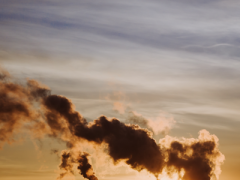Global decrease in coal burning leads to stalling of CO2 emissions in 2015
In 2015, after three years of slow growth, the growth of global CO2 emissions from fossil-fuel use and from steel and cement production was brought to a standstill. One of the main causes was the 2% global decrease in coal burning and cement production - the largest decrease over the past five decades, apart from recessions. The global decrease in CO2 emissions from coal use was offset by increasing emissions from the combustion of natural gas and oil products.
These are the main conclusions from the annual report ‘Trends in global CO2 emissions’ by PBL Netherlands Environmental Assessment Agency and the European Commission’s Joint Research Centre (EC-JRC). The report presents the outcomes of the joint JRC/PBL Emissions Database for Global Atmospheric Research (EDGAR) and preliminary estimates based on the latest statistics on energy use, including last year’s revision of coal statistics in China, and other statistics.
The estimates include all CO2 emissions from fossil-fuel combustion, waste gas flaring and other industrial non-combustion processes, such as the production of cement and ammonia. With a share of 86.5% of total CO2 emissions, fossil-fuel combustion is by far the largest source. CO2 emissions from deforestation, logging, and forest and peat fires were excluded, since they are accounted for separately and very differently in emission inventories and have a very large degree of uncertainty.
Changes in fossil-fuel mix affecting CO2 emissions
Even though fossil-fuel prices fell in 2015 in all regions, global primary energy consumption increased by 1.0% in 2015, which was similar to 2014 but well below the 10-year average increase of 1.9%. In 2015, global coal consumption decreased by 1.8%. The largest decreases in coal consumption were seen in the United States and China, both for the second year running; these decreases were partly counterbalanced by increases in India and Indonesia. Global oil and natural gas consumption increased by 1.9% and 1.7%, respectively. The largest increases in oil consumption were in China, India and the United States. The global increase in natural gas use was mainly due to increases in the United States and the European Union, with smaller increases seen in Iran and China. Since coal, compared to natural gas, produces twice as much CO2 per Joule, global CO2 emissions decreased by 0.1% in 2015. In other words, emissions stalled last year.
Top 5 emitting countries and EU account for two thirds of global CO2 emissions
In 2015, the five largest emitting countries and regions, which together account for 69% of total global CO2 emissions, were: China (30%), the United States (14%), the European Union (EU-28) (10%), India (7%), the Russian Federation (5%) and Japan (3.5%).
China and the United States reduced their emissions in 2015 by 0.7% and 2.6%, respectively. In the Russian Federation and Japan, emissions also decreased, by a respective 3.4% and 2.2%. However, these decreases were counterbalanced, in particular, by increases in India of 5.1% and in the European Union of 1.3%.
Coal-fired power plants emit one third of fossil-fuel CO2 emissions
Globally, coal combustion accounts for 41% of total CO2 emissions, and coal-fired power plants emit by far the largest share, with some 30% of all fossil-fuel combustion emissions. In all top emitting countries, the share of coal-fired power plants is large, but variable. The Chinese share, for instance, is 48%, and in India this is 47%, whereas in the United States it is 31% and in the European Union 29%. In 2015, the total amount of fossil-fuel generated electricity (from coal, gas and oil) decreased by 0.5%, while total global electricity production increased by a modest 0.9%. This decrease was mainly due to the rapid global expansion of renewable electricity sources, notably of wind and solar energy; the production of hydropower also continued to increase. The small increase in total electricity production reflects the large efficiency improvement of electrical appliances in 2015, since the average annual increase in the past 15 years was 3.3%.
Decreasing CO2 emissions in United States
Total CO2 emissions in the United States decreased by 2.6% in 2015, which was mainly due to a drop in coal consumption of 13%, representing the largest relative decrease in the use of any fossil fuel in the United States over the past five decades. In 2015, for the first time ever, the total number of kWh’s produced in the United States by gas-fired plants was almost equal to those produced by coal power. Energy-related CO2 emissions have decreased by 12% over the last 10 years. This occurred mainly in the power sector, due to a shift from coal to natural gas used in electricity generation, whereas the demand for electricity has remained fairly constant since 2005.
Structural changes towards less carbon-intensive activities in China
Other main factors in the stalling of global CO2 emissions are the structural changes in the economy and energy mix of China. Coal demand in China has been slowly declining since 2014, by 0.8% in 2014 and 1.5% in 2015. In 2015, cement and steel production also decreased. Similarly, Chinese production of fossil-fuel-related electricity decreased by 2.7% in 2015, while hydropower production increased by 5%, other renewable electricity by 21% and nuclear energy by 29%. However, oil and natural gas consumption also increased, by about 5%. As a result, China’s CO2 emissions decreased in 2015 by 0.7%, which is the first decrease since 2000 and following three years of ‘low’ annual CO2 emission growth – of 2%, 4.5% and 2%, respectively.
More information
More data and other graphics can be found at the websites of PBL and JRC:
- To the EDGAR website, with time series on 1990–2015 for all countries
- To the interactive PBL Climate Pledge-INDC tool (summary of emission reduction proposals and policies of major countries and regions and the impact by 2030)




